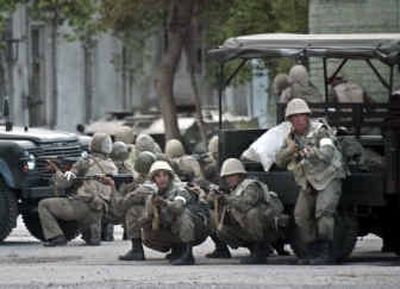Troops kill dozens of protesters in Uzbekistan

MOSCOW – Troops opened fire on thousands of protesters in the eastern Uzbek city of Andijon during a day of clashes that began Friday with armed fighters storming a prison to release inmates being held on charges of Islamic extremism.
Reports from Andijon indicated that at least several dozen people, and perhaps many more, were killed in the late-afternoon crackdown. Lutfullo Shamsutdinov, an Uzbek human rights activist who was caught up in what he called an ambush of one group of protesters by soldiers and police, said he witnessed about 200 people on the ground who appeared to be dead. Many in that group had been headed toward a military base to try to obtain weapons, he said.
The government of Uzbekistan issued no immediate statement about casualties when troops retook the Andijon city center. Nine people were killed in initial predawn clashes, the government said, during which armed fighters freed an estimated 2,000 to 4,000 inmates from the prison.
Those freed included 23 prominent local businessmen who were on trial after having set up an Islamic charity organization. They were accused of establishing a criminal organization and of religious extremism, a punishable offense in Uzbekistan. Protests over their ongoing trial had triggered the wave of unrest.
The government of President Islam Karimov has characterized the arrests of thousands of alleged Islamic radicals in recent years as part of a battle against terrorism aimed at preserving Uzbekistan as a secular society. Critics including local and foreign human rights activists say authorities have triggered a backlash by engaging in brutal suppression of people guilty of nothing more than fundamentalist religious beliefs.
The United States maintains a military base in Uzbekistan used to support operations in Afghanistan, and the Bush administration considers this Central Asian country an important ally. At the same time, Washington has criticized human rights abuses here – although not as severely as activists think it should.
“All the means by which people can express their beliefs and views peacefully have been restricted by this government,” said Allison Gill, director of the Human Rights Watch office in Tashkent, the Uzbek capital, who spoke by telephone while visiting New York. “So the only thing left is mass unrest or spontaneous uprisings. … The increasing direness of the human rights situation has led to instability.”
Through much of the day Friday, an estimated 25,000 to 50,000 protesters rallied in central Andijon. Around midday, they took control of a government building. Among those leading the protest were some of the businessmen who had been freed earlier in the day. At trial, they had maintained their innocence of the charges against them. Some of the protesters in the government building were armed, and they reportedly held some hostages.
The demonstrators’ anger not only marked an escalation of tensions over the trial of the business leaders, but appeared to reflect widespread public dissatisfaction over unemployment and poor living standards.
Both the Uzbek Interior Ministry and the presidential press office, reached by telephone Friday evening, declined comment on the day’s events.
A broad cross-section of society was represented among the demonstrators. A government statement broadcast on state television before the protest was broken up declared that “the militants are sheltering behind women, children and hostages. They will not compromise with the authorities.”
Shamsutdinov, head of the Andijon branch of the Independent Organization for Human Rights of Uzbekistan, said that at the peak of the day-long protest, about 2,000 people broke off from the main rally and set off through the city.
Shamsutdinov said he moved along with the crowd as it headed toward the military compound.
“They were stopped midway by a storm of gunfire that was coming from an ambush laid by government troops and the police,” he said. “They were literally lying in ambush behind nearby buildings, waiting for the crowd to approach.”
He described the shooting as “like an avalanche.”